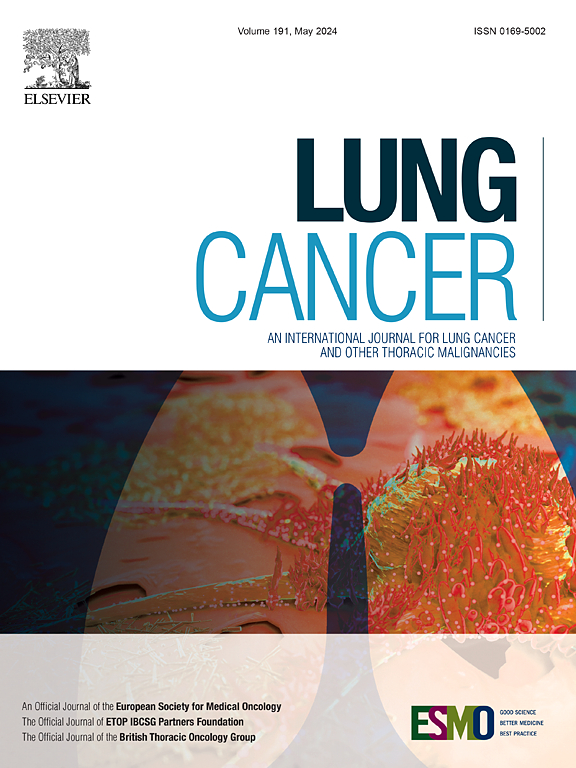净化空气:为高风险成年人提供戒烟和肺癌筛查的数字工具
IF 4.4
2区 医学
Q1 ONCOLOGY
引用次数: 0
摘要
背景:尽管肺癌筛查降低了死亡率,但使用率仍然很低。研究的重点是将戒烟纳入肺癌筛查项目,而不是向符合条件的成年人提供肺癌筛查教育。让肺癌高危人群参与进来,教育他们进行肺癌筛查,这是关键的下一步。本研究测试了数字干预提高戒烟和肺癌筛查采用的有效性。方法参与者(n = 152)被纳入一项随机对照试验,数字干预(咨询、尼古丁替代治疗、讲故事视频和肺癌筛查决策助手)与简短干预(戒烟简短建议、转介戒烟热线和邮寄肺癌筛查决策助手)。以电子方式收集人口统计、烟草和肺部健康数据。唾液可替宁试验验证了在研究开始后3个月和6个月获得的7天点流行戒断(PPA)率。采用描述性统计、Fisher精确检验、Wilcoxon秩和检验和logistic回归进行分析。结果与短时间组相比,数字干预组在3个月(35.1% vs. 15.4%, p = 0.006)和6个月(24.3% vs. 10.3%, p = 0.03)时具有更高的生化验证的7天PPA率。数字组的参与者在研究开始后6个月的肺癌筛查采用率更高(58.1%对29.5%,p <;0.001)。结论与简短干预相比,数字干预增加了戒烟和肺癌筛查的采用。在不同人群中测试数字干预是有必要的,以促进肺癌的早期发现和降低死亡率。本文章由计算机程序翻译,如有差异,请以英文原文为准。
Clearing the air: Empowering high-risk adults with digital tools for smoking cessation and lung cancer screening adoption
Background
Even though lung cancer screening decreases mortality, uptake remain low. Research has focused on integrating smoking cessation into lung cancer screening programs rather than providing lung cancer screening education to eligible adults. Engaging individuals who are at high-risk for lung cancer and educating them about lung cancer screening is a critical next step. This study tested efficacy of a digital intervention to improve smoking cessation and lung cancer screening adoption.
Methods
Participants (n = 152) were enrolled into a randomized controlled trial of a digital intervention (counseling, nicotine replacement treatment, storytelling videos, and lung cancer screening decision-aide) versus a brief intervention (brief advice for smoking cessation, referral to the Quitline and mailing lung cancer screening decision-aide). Demographic, tobacco, and lung health data were collected electronically. Salivary cotinine test verified 7-day point-prevalence abstinence (PPA) rates were obtained at 3 and 6-months after study entry. Descriptive statistics, Fisher’s exact test, Wilcoxon rank-sum test and logistic regression were used for analyses.
Results
As compared to the brief arm, the digital intervention had higher rates of biochemically verified 7-day PPA at 3 (35.1 % vs. 15.4 %, p = 0.006) and 6-months (24.3 % vs.10.3 %, p = 0.03). Participants in the digital arm had higher rates of lung cancer screening adoption at 6-months after study entry (58.1 % vs. 29.5 %, p < 0.001).
Conclusions
The digital intervention increased smoking cessation and uptake of lung cancer screening adoption compared to a brief intervention. Testing of the digital intervention among a diverse population is warranted to promote earlier detection and decreased mortality from lung cancer.
求助全文
通过发布文献求助,成功后即可免费获取论文全文。
去求助
来源期刊

Lung Cancer
医学-呼吸系统
CiteScore
9.40
自引率
3.80%
发文量
407
审稿时长
25 days
期刊介绍:
Lung Cancer is an international publication covering the clinical, translational and basic science of malignancies of the lung and chest region.Original research articles, early reports, review articles, editorials and correspondence covering the prevention, epidemiology and etiology, basic biology, pathology, clinical assessment, surgery, chemotherapy, radiotherapy, combined treatment modalities, other treatment modalities and outcomes of lung cancer are welcome.
 求助内容:
求助内容: 应助结果提醒方式:
应助结果提醒方式:


